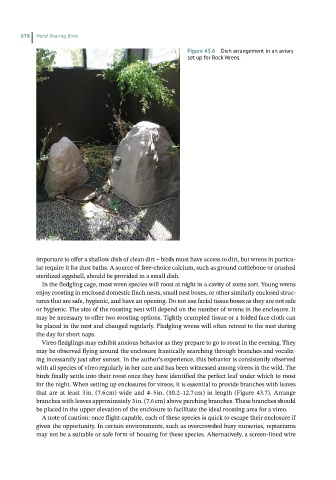Page 677 - Hand rearing birds second
P. 677
678 Hand-Rearing Birds
Figure 43.6 Dish arrangement in an aviary
set up for Rock Wrens.
important to offer a shallow dish of clean dirt – birds must have access to dirt, but wrens in particu-
lar require it for dust baths. A source of free‐choice calcium, such as ground cuttlebone or crushed
sterilized eggshell, should be provided in a small dish.
In the fledgling cage, most wren species will roost at night in a cavity of some sort. Young wrens
enjoy roosting in enclosed domestic finch nests, small nest boxes, or other similarly enclosed struc-
tures that are safe, hygienic, and have an opening. Do not use facial tissue boxes as they are not safe
or hygienic. The size of the roosting nest will depend on the number of wrens in the enclosure. It
may be necessary to offer two roosting options. Tightly crumpled tissue or a folded face cloth can
be placed in the nest and changed regularly. Fledgling wrens will often retreat to the nest during
the day for short naps.
Vireo fledglings may exhibit anxious behavior as they prepare to go to roost in the evening. They
may be observed flying around the enclosure frantically searching through branches and vocaliz-
ing incessantly just after sunset. In the author’s experience, this behavior is consistently observed
with all species of vireo regularly in her care and has been witnessed among vireos in the wild. The
birds finally settle into their roost once they have identified the perfect leaf under which to roost
for the night. When setting up enclosures for vireos, it is essential to provide branches with leaves
that are at least 3 in. (7.6 cm) wide and 4–5 in. (10.2–12.7 cm) in length (Figure 43.7). Arrange
branches with leaves approximately 3 in. (7.6 cm) above perching branches. These branches should
be placed in the upper elevation of the enclosure to facilitate the ideal roosting area for a vireo.
A note of caution: once flight‐capable, each of these species is quick to escape their enclosure if
given the opportunity. In certain environments, such as overcrowded busy nurseries, reptariums
may not be a suitable or safe form of housing for these species. Alternatively, a screen‐lined wire

